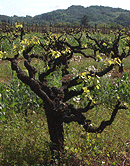|
Wineries
Wines
More Info. |

Choosing
a Wine --Mark
Twain What
Wines Will I Like? I'm often asked to compare
wines, how I feel a wine stacks up to a particular
rating, or what I feel is the best wine to buy. I
don't have any prepared answer and I rarely make a
recommendation unless I know something about the
preferences of the individual. As the above quote
points out, each individual has a unique preference
and palate. In addition, one would ask in what
conditions will the wine be consumed. As is the case of most
alcoholic and some non-alcoholic beverages (coffee,
tea, cola, etc.), taste and appreciation for wine
is acquired and progressive. It is not uncommon for
an individual to initially prefer sweet, light
wines such as Johannisburg Riesling, White
Zinfandel or Chenin Blanc. As one's tastes mature,
drier, more complex white wines such as Chardonnay
or Sauvignon Blanc may be preferred. The initial
leap to red wines may include lighter, fruity wines
such as Merlot , red table wines, or Neaveau-style
reds. To many, a preference for full-bodied,
complex reds such as Cabernet Sauvignon, Zinfandel
or Meritage-style blends is the acme of a developed
wine palate. As you taste wines, keep mental notes
as to your preferred tastes. If you
like... You might want to
try... Very Sweet, Dessert
Wines Muscat Canelli, Late
Harvest Riesling Sweet White or Blush
Wines White Zinfandel,
Johannisburg Riesling Light or Semi-Dry
Whites Chenin Blanc,
Viognier, Dry Riesling, Gewurtztraminer,
Pinot Blanc Dry or Full-Bodied
Whites Chardonnay,
Sauvignon Blanc Fruity
Reds Neaveau-Style Reds,
Grenache Light to Medium
Reds Merlot, Pinot Noir,
Barbera Fruity,
Medium-Bodied Reds Zinfandel, Syrah,
Bordeaux Blends (Meritage) Full-Bodied
Reds Cabernet Sauvignon,
Cabernet Franc Tasting wines at a winery or
tasting room offers one the luxury of finding a
wine he or she likes before buying it. It would be
nice to walk into a walk into a wine retailer and
do the same. Unfortunately, most of us are at the
mercy of buying a wine we are most familiar with,
hearing of one from a third party, or buying blind.
When wishing to try a new wine, one can minimize
the risk of buying a poor wine with just a little
knowledge. Remember that a more costly
wine doesn't necessarily mean a better wine and
that a high rating or rave review doesn't mean that
you are going to like it. Being able to interpret
the label and buying from a reputable and
knowledgeable source are your best chance to find
the right wine. Factors
in Buying Wine Description Most individuals tend to like
certain specific characteristics of a wine, whether
it's a citrusy Chardonnay or a
peppery Zinfandel. Many wine bottles have a
label that contains the winemaker's notes or
describes the characteristics of the wine and it is
good advice to read these notes. Some better wine
retailers will display a description of the wine or
a review along side the wines. Since taste in wines
is subjective, it is not recommended to purchase
wines strictly on a wine's "score." Environment of
Retailer Since most people buy their
wines from a wine store, supermarket or drug store,
the environment in which the wines are stored is
important. Wines will keep longer if stored on
their sides, however if the store has a rapid
turnover then there is little consequence to wines
stored upright. Wines are best stored in a
constant, cool environment and away from direct
sunlight. Knowledgeable
Staff A wine store (or a retailer
with a sizeable wine department) will most likely
have a knowledgeable staff in which one can get
recommendations. Since personal taste is vastly
different among individuals, it is always best to
first describe the types of wines, flavors and
particular favorite wines one likes before asking
for advice. It is also very important to describe
what the wine will be served with and how much you
wish to spend. It is too often the case that a
person will spend much more on a wine than is
desired because he/she felt intimidated by
cost. Inspect the
Bottle A simple inspection of the
bottle can avert a wine fiasco. Check to see that
there is no sticky residue on the neck of the
bottle and that the bottle's fill level is
consistent with other bottles. The top surface of
the wine should not be seen below the lower edge of
the foil, or with the newer foil-less bottles, more
than 1 inch below the bottom of the
cork. Try Wines Before Buying in
Bulk Although many retailers will
provide case discounts ( often 5 or 10 percent), it
is unwise to buy wines in quantity without tasting
the wine first. People often buy cases of wine
solely based on a particular rating or
recommendation from a friend or wine merchant only
to find that the wine does not suit their
taste. Next in this
series: Serving
Wine |
